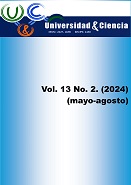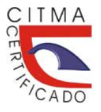Coccinellids and their functional role as bioregulators of pests in crops in the province of Ciego de Avila
DOI:
https://doi.org/10.5281/zenodo.10962497Keywords:
coccinellids, functional role, insects, predatorAbstract
The present research was carried out at the La Cruz Verde Farm and the Bioplant Center, at the Maximo Gomez Baez University, also at the La Cuba Various Crops Company in Ciego de Ávila, in the period from September 2020 to April 2022 with the objective of determining the coccinellids present in corn, beans, sorghum, and banana and their functional role in these crops. To collect and take samples of the insects, periodic inspections were carried out once a week in the field, for this the entomological network was used, as well as the use of manual collection techniques, in order to facilitate the capture of harmful and beneficial insectile agents. For their identification and taxonomic classification, they were taken to the Entomology laboratory of the Faculty of Agricultural Sciences, to the provincial Plant Health laboratory, to the National Institute of Plant Health and to the Department of Plant Health of the Central University of Las Villas. As a result, achieved, it was determined that in the province of Ciego de Avila in the crops of corn, beans, sorghum, and banana there is a richness of 8 species of coccinellids that are grouped into six genera, the most important being Cycloneda sangre. Furthermore, it was possible to analyze the functional role that coccinellids perform on insects that attack crops of great economic importance such as corn, beans, sorghum and banana. In the research, it was confirmed that coccinellids prey on insects of various genera and families, with the order Hemiptera and the family Aphidae being of greatest relevance, since we confirmed that their preferred delicacy is aphids.
Downloads
References
Aktar, W., Sengupta, D. y Chowdhury, A. (2009). Impact of pesticidas use in agricultura: Their benefits and hazards. Interdisciplinary Toxicology, 2(1), 1-12.
Alayo R.S. y A. Blahutiak. (1981). Parasito y depredadores que atacan a Saissetia hemisphaerica Targ (Homóptera: Coccidae) en Cuba. Poeyana, 226, 1-4.
Amoabeng, B. W., Stevenson, P. C., Mochiah, B. M., Asare, K. P., y Gurr, G. M. (2020). Scope for non-crop plants to promote conservation biological control of crop pests and serve as sources of botanical insecticides. Scietifics Reports, 10, 1-15.
Andrade, G., Henao R. y Triviño P. (2013). Técnicas y procesamiento para la recolección, preservación y montaje de Mariposas en estudios de biodiversidad y conservación. (Lepidoptera: Hesperioidea – Papilionoidea). Revista de la academia colombiana de ciencias exactas, físicas y naturales, 37(144), 311–325. https://doi.org/10.18257/raccefyn.12
Bruner, S.C., Scaramuzza L. C., y Otero A. R. (1975). Catálogo de los insectos que atacan a las plantas económicas de Cuba. Academia de Ciencias de Cuba, Instituto de Zoología.
Castillo, C.C., Gallegos, P G. y Causton, C. E. (2020). Biological control in continental Ecuador and the Galapagos Islands. En J. C. van Lenteren, V. H. P. Bueno, M. G. Luna, y Y. C. Colmenarez (Eds.), Biological Control in Latin America and the Caribbean: Its Rich History and Bright Future (pp. 220–244). CAB International.
Castillo, C. I. (2020). Biodiversity in Ecuador and Its Immense Potential for Agricultural Pest Control. En D. Chong, Pablo, Newman, David, Steinmacher (Ed.), Agricultural, Forestry and Bioindustry Biotechnology and Biodiscovery (pp. 143–162). Springer.
Culliney, T. (2014). Crop Losses to Arthropods. In: Pimentel, D., Peshin, R. (eds) Integrated Pest Management. Springer, Dordrecht. https://doi.org/10.1007/978-94-007-7796-5_8
Helmuth, W. (2001). Cultivo de Maíz. Manual Manejo Integrado de Plagas en cultivos de la Amazonía Ecuatoriana. Mossaico; p. 136. Quito.
Karp. D., Chaplin, R., Meehan, T. y You, Z. (2018). Crop pests and predators exhibit inconsistent responses to surrounding landscape composition. Journal of Applied Ecology. https://doi/10.1073/pnas.1800042115
Mendoza, F. (1982). Principales insectos que atacan a cultivos económicos de Cuba. Editorial Pueblo y Educación.
Milán, O., Esson, I., Corona, T. y Rodríguez, L.A. (2008). Prospección de los coccinélidos benéficos asociados a Los coccinélidos benéficos en Cuba. Historia... plagas y cultivos en Cuba. Fitosanidad, 12(2):71-78.
Murúa, G. y E. Virla. (2015). A laboratory study. Acta Zoológica Mexicana, (nueva serie.), 20, 199-210, México.
Naranjo, A. (2017). La otra guerra: Situación de los plaguicidas en Ecuador (Agencia Ec).
Peck, S. (2005). A Checklist of the Beetles of Cuba with Data on Distributions and Bionomics (Insecta: Coleoptera). Arthropods of Florida and Neighboring Land Areas, 18,136-139, Florida.
Savary, S., Ficke, A., Aubertot, J. N., y Hollier, C. (2012). Crop losses due to diseases and their implications for global food production losses and food security. Food Security, 4(4), 519–537.
Van Driesche, R., Winston, R. L., y Duan, J. J. (2020). Classical insect biocontrol in North America, 1985 to 2018: a pest control strategy that is dying out? CAB Reviews: Perspectives in Agriculture, Veterinary Science, Nutrition and Natural Resources, 15(037), 1-9.
Vázquez, L. y Pérez, N. (2017). El control biológico integrado al manejo territorial de plagas de insectos en Cuba. Agroecología, 12(1), 39-46.
Vélez, E.A. (2009). Biodiversidad de fitófagos y enemigos naturales asociados al cultivo de maíz (Zea mays l.) en las fincas integrales de Jatun Paccha y Santa Clara. [Tesis]. http://repositorio.uea.edu.ec/xmlui/handle/123456789/47
Zayas F. (1981). Entomofauna cubana. Tomo VIII. Ed. Científico Técnica.
Downloads
Published
How to Cite
Issue
Section
License
Copyright (c) 2024 Universidad & ciencia

This work is licensed under a Creative Commons Attribution-NonCommercial-ShareAlike 4.0 International License.





















